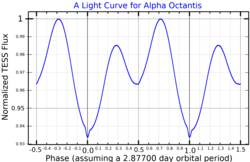| Observation data Epoch J2000.0 Equinox J2000.0 (ICRS) | |
|---|---|
| Constellation | Octans |
| Right ascension | 21h 04m 43.06347s[2] |
| Declination | −77° 01′ 25.5735″[2] |
| Apparent magnitude (V) | 5.13[3] |
| Characteristics | |
| Spectral type | F4III + F5III (spectroscopic binary)[4] |
| U−B color index | +0.13[5] |
| B−V color index | +0.490±0.008[3] |
| Variable type | EB[6] |
| Astrometry | |
| Radial velocity (Rv) | 85.9±1.5[3] km/s |
| Proper motion (μ) | RA: +22.5215[2] mas/yr Dec.: −369.325[2] mas/yr |
| Parallax (π) | 22.5215 ± 0.0955 mas[2] |
| Distance | 144.8 ± 0.6 ly (44.4 ± 0.2 pc) |
| Absolute magnitude (MV) | 1.93±0.02[7] |
| Orbit[4] | |
| Period (P) | 9.073 d |
| Eccentricity (e) | 0.39 |
| Periastron epoch (T) | 2,435,302.404 |
| Argument of periastron (ω) (secondary) | 276° |
| Semi-amplitude (K1) (primary) | 47 km/s |
| Semi-amplitude (K2) (secondary) | 47 km/s |
| Details | |
| Mass | 1.42[8] M☉ |
| Radius | 3.69[9] R☉ |
| Temperature | 6,270[7] K |
| Metallicity [Fe/H] | 0.07[7] dex |
| Rotational velocity (v sin i) | 85[10] km/s |
| Age | 1.5±0.1[7] Gyr |
| Other designations | |
| Database references | |
| SIMBAD | data |
Alpha Octantis is a binary star[12] system in the constellation of Octans. The name is Latinized from α Octantis. Despite being labeled the "alpha" star by Lacaille, it is not the brightest star in the constellation—that title belongs to Nu Octantis. It is visible to the naked eye as a faint, yellow-white-hued point of light with an overall apparent visual magnitude of approximately 5.13.[3] The system is located approximately 148 light-years away from the Sun based on parallax.
This is a double-lined spectroscopic binary star which consists of two similar giant stars, each with spectral type F, orbiting each other with a period of just over 9 days and an eccentricity of 0.39.[4] The pair form a Beta Lyrae-type eclipsing binary system, dropping by magnitude 0.04 during the primary eclipse.[6] This system is a bright X-ray source with a luminosity of 22.78×1029 ergs s−1.[13] The system displays an infrared excess suggesting the presence of two debris disks; the first has a temperature of 450 K and is orbiting at a distance of 1.40 AU from its host star, while the second is a much cooler 40 K and orbits 187.8 AU from the system.[9]
References
- ^ "MAST: Barbara A. Mikulski Archive for Space Telescopes". Space Telescope Science Institute. Retrieved 8 December 2021.
- ^ a b c d e Brown, A. G. A.; et al. (Gaia collaboration) (August 2018). "Gaia Data Release 2: Summary of the contents and survey properties". Astronomy & Astrophysics. 616. A1. arXiv:1804.09365. Bibcode:2018A&A...616A...1G. doi:10.1051/0004-6361/201833051. Gaia DR2 record for this source at VizieR.
- ^ a b c d Anderson, E.; Francis, Ch. (2012). "XHIP: An extended hipparcos compilation". Astronomy Letters. 38 (5): 331. arXiv:1108.4971. Bibcode:2012AstL...38..331A. doi:10.1134/S1063773712050015. S2CID 119257644.
- ^ a b c The double-lined binary alpha Octantis, William Buscombe and Pamela M. Morris, The Observatory 80 (February 1960), pp. 28–29, Bibcode:1960Obs....80...28B.
- ^ HR 8021, database entry, The Bright Star Catalogue, 5th Revised Ed. (Preliminary Version), D. Hoffleit and W. H. Warren, Jr., CDS ID V/50. Accessed on line September 4, 2008.
- ^ a b Samus', N. N; et al. (2017). "General catalogue of variable stars". Astronomy Reports. 5.1. 61 (1): 80. Bibcode:2017ARep...61...80S. doi:10.1134/S1063772917010085. S2CID 125853869.
- ^ a b c d Nordström, B.; et al. (2004). "The Geneva-Copenhagen survey of the Solar neighbourhood. Ages, metallicities, and kinematic properties of ˜14 000 F and G dwarfs". Astronomy and Astrophysics. 418: 989–1019. arXiv:astro-ph/0405198. Bibcode:2004A&A...418..989N. doi:10.1051/0004-6361:20035959. S2CID 11027621.
- ^ Tokovinin, A.; et al. (May 2006), "Tertiary companions to close spectroscopic binaries", Astronomy and Astrophysics, 450 (2): 681–693, arXiv:astro-ph/0601518, Bibcode:2006A&A...450..681T, doi:10.1051/0004-6361:20054427, S2CID 8899546
- ^ a b Cotten, Tara H.; Song, Inseok (July 2016), "A Comprehensive Census of Nearby Infrared Excess Stars", The Astrophysical Journal Supplement Series, 225 (1): 24, arXiv:1606.01134, Bibcode:2016ApJS..225...15C, doi:10.3847/0067-0049/225/1/15, S2CID 118438871, 15.
- ^ van Belle, Gerard T. (March 2012). "Interferometric observations of rapidly rotating stars". The Astronomy and Astrophysics Review. 20 (1): 51. arXiv:1204.2572. Bibcode:2012A&ARv..20...51V. doi:10.1007/s00159-012-0051-2. S2CID 119273474.
- ^ "* alf Oct". SIMBAD. Centre de données astronomiques de Strasbourg. Retrieved September 4, 2008.
- ^ Eggleton, P. P.; Tokovinin, A. A. (September 2008). "A catalogue of multiplicity among bright stellar systems". Monthly Notices of the Royal Astronomical Society. 389 (2): 869–879. arXiv:0806.2878. Bibcode:2008MNRAS.389..869E. doi:10.1111/j.1365-2966.2008.13596.x. S2CID 14878976.
- ^ Makarov, Valeri V. (October 2003), "The 100 Brightest X-Ray Stars within 50 Parsecs of the Sun", The Astronomical Journal, 126 (4): 1996–2008, Bibcode:2003AJ....126.1996M, doi:10.1086/378164.
External links
- Alpha Octantis, Jim Kaler, Stars.

